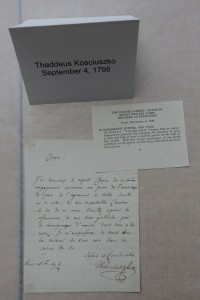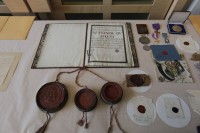 The FBI announced Wednesday that they have returned more than 120 important historical artifacts and documents that were stolen decades ago from the Polish Museum of America (PMA). The artifacts, including letters going as far back as 1646, correspondence to and from Polish kings, documents with massive royal seals still attached, letters written by George Washington, Thomas Jefferson, Napoleon Bonaparte and Revolutionary War hero Thaddeus Kosciuszko, rare artworks, Polish military medals and Nazi World War II propaganda, have an estimated market value of $5 million. Their value to the museum and to the historical record is of course incalculable.
The FBI announced Wednesday that they have returned more than 120 important historical artifacts and documents that were stolen decades ago from the Polish Museum of America (PMA). The artifacts, including letters going as far back as 1646, correspondence to and from Polish kings, documents with massive royal seals still attached, letters written by George Washington, Thomas Jefferson, Napoleon Bonaparte and Revolutionary War hero Thaddeus Kosciuszko, rare artworks, Polish military medals and Nazi World War II propaganda, have an estimated market value of $5 million. Their value to the museum and to the historical record is of course incalculable.
 The Chicago museum, one of the oldest ethnic museums in the country, has an extensive permanent collection of artifacts relating to Polish history and the history of Poles in the United States. At some point during the 1970s or 1980s, important objects began to disappear. It was done sneakily enough and the collection is large enough that nobody even guessed they were gone until years later. None of the museum employees who worked in there in the 80s are still there, so there was nothing definite to go on, just a lot of rumors and speculation.
The Chicago museum, one of the oldest ethnic museums in the country, has an extensive permanent collection of artifacts relating to Polish history and the history of Poles in the United States. At some point during the 1970s or 1980s, important objects began to disappear. It was done sneakily enough and the collection is large enough that nobody even guessed they were gone until years later. None of the museum employees who worked in there in the 80s are still there, so there was nothing definite to go on, just a lot of rumors and speculation.
 The case busted wide open thanks to a Chicago coin and antiquities dealer named Harlan Berk. In late summer of 2011, unnamed youths came to his store bearing documents filled with Polish names and the signatures of Founding Fathers. They claimed they had found the items in the basement of the house they were renting and that they had many more items to sell. Berk purchased the letters and the sellers came back several times with more impressive artifacts.
The case busted wide open thanks to a Chicago coin and antiquities dealer named Harlan Berk. In late summer of 2011, unnamed youths came to his store bearing documents filled with Polish names and the signatures of Founding Fathers. They claimed they had found the items in the basement of the house they were renting and that they had many more items to sell. Berk purchased the letters and the sellers came back several times with more impressive artifacts.
 In a break from the see-no-evil way so many antiquities dealers operate, Berk did his own research to figure out what these documents were and where they came from. When he discovered that at some point they had been in the PMA collection, he called museum president Maria Ciesla and told her he had something of theirs.
In a break from the see-no-evil way so many antiquities dealers operate, Berk did his own research to figure out what these documents were and where they came from. When he discovered that at some point they had been in the PMA collection, he called museum president Maria Ciesla and told her he had something of theirs.
“I couldn’t catch my breath because this was a phone call we had dreamed about getting,” Ciesla said. “This was the first tangible proof that this was not a rumor, that these were out there, that these documents and artifacts were out there.”
“This is something that we had dreamed and hoped for for so many years,” Ciesla said. “It is so important for us to have this safely back not only for the rich Polish history but also for the wonderful American history. It is so important to the world stage.”
 She called the FBI Art Crime Team and they opened an investigation. She also arranged with Berk that he would continue buying anything the sellers brought in to the store, and then he’d turn them over to the museum which would reimburse him the purchase cost. In October of 2011, the sellers got greedy. The papers with the royal seals looked so fancy that they thought they could make a killing selling them at auction rather than just settling for Berk’s price. Fearing that the objects might get dispersed, the FBI stepped in.
She called the FBI Art Crime Team and they opened an investigation. She also arranged with Berk that he would continue buying anything the sellers brought in to the store, and then he’d turn them over to the museum which would reimburse him the purchase cost. In October of 2011, the sellers got greedy. The papers with the royal seals looked so fancy that they thought they could make a killing selling them at auction rather than just settling for Berk’s price. Fearing that the objects might get dispersed, the FBI stepped in.
The sellers promptly agreed to hand over everything they had left. The FBI discovered that the house they were renting was owned by the mother of a former curator at the PMA. The identities of the curator and his or her mother have not been released. It would certainly explain how so many precious artifacts could just walk away without anyone realizing it if the museum curator was the thief. It reminds me of the exploits of presidential inauguration expert, liar and thief Barry Landau, who used his exalted reputation as a cover for years of stealing.
No criminal charges will be filed. Museum officials can’t say for sure when the objects were stolen, but it was certainly more than five years ago which means the statute of limitations on the original theft has expired. The renters who stumbled on this treasure in the basement won’t be charged with transportation, sale or possession of stolen goods, probably because they’re just young and stupid rather than malicious.
Ciesla says the next step is to fully catalogue the returned artifacts. When that’s done, they will all go on exhibit together, probably within the next two years. Meanwhile the museum is asking that everyone keep their eyes open for any other Polish-intensive artifacts. There’s no telling what other gems might have been sold before the leftovers were stashed in the basement.